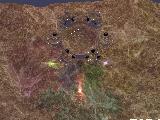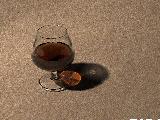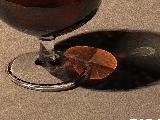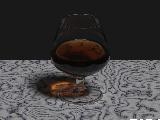
After noticing the nice caustic through a glass of cognac one late evening I decided to simulate it. Not having a 3d-model of a cognac glass (or a modeling package) I ended up writing a program that would take a number of sample points a generate a smooth spline curve, which was then used to generate a surface of revolution. This image was rendered on a P-90 in 4 hours using 64 samples per pixel, and something around 200.000 photons for the caustic. Notice the detail in the caustic as well as the smoothly connected caustic & shadow boundary. The high number of pixel-samples was necessary to reduce noise in the depth-of-field simulation.









